| Pages:
1
2
3
4
..
6 |
plante1999
International Hazard
    
Posts: 1936
Registered: 27-12-2010
Member Is Offline
Mood: Mad as a hatter
|
|
Gas all the equipment with H2S, and filter paper, washes etc is put into the ground. After all, realgar and orpiment are sulphides...
I never asked for this.
|
|
|
elementcollector1
International Hazard
    
Posts: 2684
Registered: 28-12-2011
Location: The Known Universe
Member Is Offline
Mood: Molten
|
|
Makes sense. What about the reaction products from the leach with NaOH? I can't find any balanced equation for either sodium arsenite
(NaAsO2 or Na3AsO3). I would assume the products would be the arsenite, some oxide or hydroxide of cobalt, and
possibly water or hydrogen.
EDIT: I have found one balanceable reaction.
11 O2 + 36 NaOH + 4 CoAs3 -> 12 Na3AsO3 + 18 H2O + 4 CoO
Does this seem at all feasible? It would take some time for the oxygen in the air to react with the fused mixture of the ore and the sodium hydroxide,
and I wouldn't be able to tell when it was done (except that the ore would have turned into a black powder?)
[Edited on 12-22-2013 by elementcollector1]
Elements Collected:52/87
Latest Acquired: Cl
Next in Line: Nd
|
|
|
woelen
Super Administrator
        
Posts: 8012
Registered: 20-8-2005
Location: Netherlands
Member Is Offline
Mood: interested
|
|
I have tried the reaction between As2O3 (dissolved in excess HCl) with SnCl2. This reaction is fairly facile, but it is not clean. You get very impure
arsenic (dirty brown stuff). I also tried making As with NaH2PO2 instead of SnCl2, but this is not working very well. You get very pure fine crystals
of As, but the yield is pathetic. From 1.5 grams of As2O3 I only get 100 mg or so of arsenic after hours and hours of heating, it simply won't react
easily.
I did not yet find an aqueous method of making As from its compounds (I have some As2O3 and I have some orpiment from eBay sellers). All well-known
methods require heating and deposition of vapors. This is something I certainly will not do at home, I do not want to poison myself with As-vapors.
|
|
|
blogfast25
International Hazard
    
Posts: 10562
Registered: 3-2-2008
Location: Neverland
Member Is Offline
Mood: No Mood
|
|
There's an old forensic test which consists of plating out the As on copper wire, from an AsCl3 solution. See Reinsch test:
http://en.wikipedia.org/wiki/Reinsch_test
[Edited on 22-12-2013 by blogfast25]
|
|
|
elementcollector1
International Hazard
    
Posts: 2684
Registered: 28-12-2011
Location: The Known Universe
Member Is Offline
Mood: Molten
|
|
In the much higher concentrations expected of this experiment, do you think it would still be a 'plating' or more akin to the copper 'tree' from
CuSO4 and Fe?
@woelen: I don't mind pathetic yields in this case, as I only have to make a pure, visible sample - even 100mg is acceptable (I ampouled this amount
of palladium, and it looked fine). I agree that I'd really rather not handle any vaporous compound of arsenic, hence the query above about leaching
with molten NaOH and air.
Elements Collected:52/87
Latest Acquired: Cl
Next in Line: Nd
|
|
|
blogfast25
International Hazard
    
Posts: 10562
Registered: 3-2-2008
Location: Neverland
Member Is Offline
Mood: No Mood
|
|
Quote: Originally posted by elementcollector1  |
In the much higher concentrations expected of this experiment, do you think it would still be a 'plating' or more akin to the copper 'tree' from
CuSO4 and Fe?
|
I've no idea, it's conditions dependent, I would think...
|
|
|
elementcollector1
International Hazard
    
Posts: 2684
Registered: 28-12-2011
Location: The Known Universe
Member Is Offline
Mood: Molten
|
|
Hmm. Something to try, but I should probably go with the hypophosphite method (which will unfortunately involve distilling white phosphorus and
reacting with NaOH, due to lack of availability).
EDIT: Found in an earlier thread that apparently tartaric acid can take care of the tin contamination, but I need more clarification on this:
| Quote: | Other people seem to be happy with reduction with As+3. Here they use warm very conc. HCl with their SnCl2, using tartaric acid to produce a
precipitate free of tin. The actual analysis using iodine titration seems typical.
http://books.google.com/books?id=40QPAAAAIAAJ&pg=PA316
But a couple different authors say that As+5 is not so fast to be reduced.
Really there are very many articles over the years using either hypophosphite or SnCl2 in some way for quantitative analysis of arsenic, but this does
not necessarily apply here. |
Quote is from S.C.Wack, in this thread.
[Edited on 12-23-2013 by elementcollector1]
Elements Collected:52/87
Latest Acquired: Cl
Next in Line: Nd
|
|
|
elementcollector1
International Hazard
    
Posts: 2684
Registered: 28-12-2011
Location: The Known Universe
Member Is Offline
Mood: Molten
|
|
Found what I think is the reaction mechanisms for the full process I intend to follow, based on balanceable reactions and all products being
water-soluble except for As at the end.
First, CoAs3 is powdered and fused with NaOH and air for a long period of time:
4 CoAs3 + 36 NaOH + 11 O2 -> 12 Na3AsO3 + 18 H2O + 4CoO
The sodium arsenite is dissolved in water, and the insoluble cobalt oxide is filtered off.
In solution, the sodium arsenite is acidified. This precipitates As2O3.
12 Na3AsO3 + 36 HCl -> 6 As2O3 + 36 NaCl + 18 H2O
The supernatant solution is decanted, and the arsenic oxide is dried. It is then dissolved in an excess of fresh HCl.
6 As2O3 + 36 HCl -> 12 AsCl3 + 18 H2O
Meanwhile, sodium hypophosphite is reacted with hot, concentrated HCl.
NaH2PO2 + HCl -> NaCl + H3PO2
The phosphinic acid is added to the arsenic trichloride, and with much heating, some small amount of arsenic precipitates.
12 AsCl3 + 12 H3PO2 -> 12 As + 12 POCl3 + 12 H2O + 6 H2
The POCl3 immediately reacts with the water.
POCl3 + 3 H2O -> 3 HCl + H3PO4
There are a few caveats to this reaction pathway:
-As must not be reactive with HCl. I cannot find a reference that says it does react, nor can I find one that says it doesn't.
-As must also not be reactive with phosphoric acid.
-H2 must be released - but no one has commented on any gas evolution?
For 100g of CoAs3 at the beginning, the theoretical yield of pure arsenic is 80g. Given woelen's comment on an earlier arsenic thread about
a yield of less than 7% using the hypophosphite method, the expected yield is about 5.6g As, which is almost exactly enough to fill a 1mL ampoule.
Elements Collected:52/87
Latest Acquired: Cl
Next in Line: Nd
|
|
|
blogfast25
International Hazard
    
Posts: 10562
Registered: 3-2-2008
Location: Neverland
Member Is Offline
Mood: No Mood
|
|
Quote: Originally posted by elementcollector1  | -As must not be reactive with HCl. I cannot find a reference that says it does react, nor can I find one that says it doesn't.
-As must also not be reactive with phosphoric acid.
-H2 must be released - but no one has commented on any gas evolution?
|
As won't react with acids to any appreciable degree, I think. The element is still too non-metallic to react directly with non-oxidising acids. It
probably responds to HNO3.
That Reinsch test is also carried out in acid conditions.
[Edited on 24-12-2013 by blogfast25]
|
|
|
elementcollector1
International Hazard
    
Posts: 2684
Registered: 28-12-2011
Location: The Known Universe
Member Is Offline
Mood: Molten
|
|
Ah. That works out perfectly then.
Elements Collected:52/87
Latest Acquired: Cl
Next in Line: Nd
|
|
|
AJKOER
Radically Dubious
    
Posts: 3026
Registered: 7-5-2011
Member Is Offline
Mood: No Mood
|
|
Hee is a comment from Atomistry.com on isolating Arsenic (link: http://arsenic.atomistry.com/production.html ):
"Metallic arsenic is sometimes obtained from arsenious oxide. Thus in Altenberg (Silesia) the oxide is heated at 650° to 700° C. with charcoal in an
earthenware crucible covered with a conical iron cap which acts as receiver, while in Chicago retorts composed of steel pipes large enough to take a
charge of 450 lbs. were at one time used for the same purpose, the arsenic being collected in water-cooled pipe condensers. This reduction method is
not satisfactory, however, as the product is largely amorphous and is not so desirable as the crystalline form, being suitable only for making arsenic
compounds. Moreover it always contains arsenious oxide. A Japanese method consists in fixing the vapour of arsenious oxide by means of ferric oxide or
alumina at a temperature above 218° C. and then reducing the product with water-gas, Mond gas or producer gas above 100° C.; the arsenic thus freed
is then sublimed. "
The Japanese method sounds interestingly.
|
|
|
elementcollector1
International Hazard
    
Posts: 2684
Registered: 28-12-2011
Location: The Known Universe
Member Is Offline
Mood: Molten
|
|
It sounds interesting, but high-temperature reduction is not something I'd like to try if it can be avoided.
Elements Collected:52/87
Latest Acquired: Cl
Next in Line: Nd
|
|
|
elementcollector1
International Hazard
    
Posts: 2684
Registered: 28-12-2011
Location: The Known Universe
Member Is Offline
Mood: Molten
|
|
Attempting the first step (ore and molten sodium hydroxide). Pics forthcoming.
Elements Collected:52/87
Latest Acquired: Cl
Next in Line: Nd
|
|
|
BobD1001
Hazard to Others
  
Posts: 182
Registered: 29-3-2013
Member Is Offline
Mood: No Mood
|
|
Looking forward to the results!
|
|
|
elementcollector1
International Hazard
    
Posts: 2684
Registered: 28-12-2011
Location: The Known Universe
Member Is Offline
Mood: Molten
|
|
Aqueous analysis is not started yet, but here are some photos of the reaction!
First, a pic of the mineral itself. It weighs 120g, and looks extremely metallic in nature. For something that behaves and looks like a metal or
alloy, this stuff is remarkably fragile - likely due to the high arsenic content? This was from one hit with a hammer.
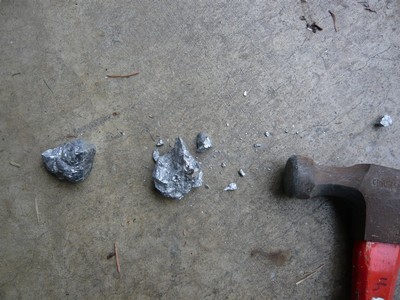
Next, the mix: 2.5g of skutterudite and 3.5g of NaOH (adjusted upward from stoichiometry due to hydration).
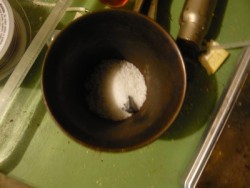
The setup (the crucible on a hot plate, turned to max):
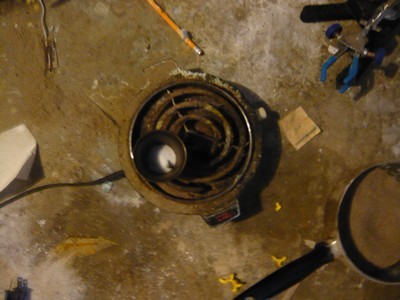
During the reaction, noticeable gas evolution was observed. According to the reaction schema I stated in a previous post, this should be
H2O boiling off, but could also be As2O3 sublimating - this is discussed farther down. Additionally, significant
amounts of skutterudite were still present after the hot plate was turned off - with more heating, these may have disappeared.
And finally, after pretty much one hour of heating, the post-reaction mix (some more NaOH was added because I thought it was somehow boiling to
dryness):
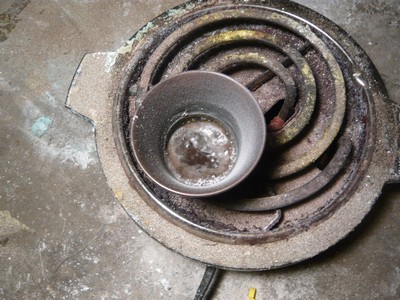
I think that brown stuff is CoO? I'm not sure.
A new worry I thought of is that the produced Na3AsO3 might have just decomposed, and the As2O3 sublimated
away. Well, I guess we'll see if there's any soluble arsenic in the aqueous extraction. If not, there's really no point to the molten procedure - it
would be the same in terms of what happens to the arsenic when the ore is heated in air.
In that case, would an extraction with concentrated aqueous NaOH and somewhat (~15%) concentrated H2O2 do the trick?
Elements Collected:52/87
Latest Acquired: Cl
Next in Line: Nd
|
|
|
Random
International Hazard
    
Posts: 1120
Registered: 7-5-2010
Location: In ur closet
Member Is Offline
Mood: Energetic
|
|
If As2O3 is sublimating away it can't be a good thing. Try to catch at least some of this stuff by having something chilled on top of the crucible.
|
|
|
blogfast25
International Hazard
    
Posts: 10562
Registered: 3-2-2008
Location: Neverland
Member Is Offline
Mood: No Mood
|
|
EC1:
Was the ore powdered prior to fusion?
Usually these fusions prescribe twice the weight of alkali to ore, sometimes more.
Using finely ground powders, I've 'cracked' materials like Beryl, Zircon and food grade TiO2 in a matter of about 20 minutes, by fusion with KOH. Once
steam evolution is over, the reaction is essentially over, heating further won't do much if anything.
I must warn you again of the dangers of arsenic, especially as you now seem not to know what's become of it! 
Arsenic oxide's BP is 465 C, that sounds a little high for a hot plate.
[Edited on 28-12-2013 by blogfast25]
|
|
|
elementcollector1
International Hazard
    
Posts: 2684
Registered: 28-12-2011
Location: The Known Universe
Member Is Offline
Mood: Molten
|
|
Quote: Originally posted by blogfast25  | EC1:
Was the ore powdered prior to fusion?
Usually these fusions prescribe twice the weight of alkali to ore, sometimes more.
Using finely ground powders, I've 'cracked' materials like Beryl, Zircon and food grade TiO2 in a matter of about 20 minutes, by fusion with KOH. Once
steam evolution is over, the reaction is essentially over, heating further won't do much if anything.
I must warn you again of the dangers of arsenic, especially as you now seem not to know what's become of it! 
Arsenic oxide's BP is 465 C, that sounds a little high for a hot plate.
[Edited on 28-12-2013 by blogfast25] |
The ore was in the form of 3-5mm irregular granules (which are now somehow welded onto the crucible...). Not the best for fusion, but my original
intent was to see if I could measure an appreciable loss of mass, and given the expected CoO powder, granules would be better separated from the end
mixture. Judging from the granules present, there was no appreciable loss of mass - not even half a gram. This indicates either a longer melt was
needed, or the reaction does not proceed under these conditions. Noticeably, the ore granules were significantly darkened afterwards, indicating
surface oxidation to black CoO.
Steam evolution did seem to occur, though I was unsure what gas was being produced at the time. But considering that the heating element was red-hot
(faintest of glows in daylight, much stronger in shadow) and this thing barely reaches 200 C with a sandbath, I doubt that it can sublimate arsenic
under any conditions.
Well, at least I know what's become of most of it. It's probably worth testing the aqueous extraction for any arsenic, but any oxide precipitation
will be on the order of milligrams at most, meaning the solution needs to be heavily concentrated.
The thing is, in your cases, the metal/element in question was a cation. Here, arsenic is an anion - so how does that play differently?
EDIT: I took a look at the stoichiometry, and according to the reaction, if it were to proceed to completion, about 0.88 liters of steam should have
been driven off (about 0.7 mL of liquid). There was nowhere near this much steam, and given that some reaction clearly occurred (the brown powder,
blackening of the ore particles, some gas evolution) I would say that the reaction is indeed happening. Just very slowly, and very inefficiently due
to the particle size. Perhaps another test with very fine powder is in order...
EDIT.2: The pertinent reaction for an aqueous extraction would be
11 H2O2 + 18 NaOH + 2 CoAs3 -> 20 H2O + 2 CoO + 6 Na3AsO3
I'm imagining that this might proceed, but the molten process would be more efficient.
[Edited on 12-29-2013 by elementcollector1]
Elements Collected:52/87
Latest Acquired: Cl
Next in Line: Nd
|
|
|
blogfast25
International Hazard
    
Posts: 10562
Registered: 3-2-2008
Location: Neverland
Member Is Offline
Mood: No Mood
|
|
Firstly I'm somewhat surprised your ore didn't appreciably react with molten NaOH. Pure arsenic should do that quite vigorously, I should think.
But the arsenic isn't necessarily present as an anion: the ore appears to be an alloy or intermetallic compound (even if As doesn't really qualify as
a metal). Have a look at its structure:
http://en.wikipedia.org/wiki/Skutterudite
I wonder if this stuff reacts appreciably with hot, conc. sulphuric acid, which might get a handle on the cobalt.
Aqua Regia (even the 'poor man's version') might also dissolve it through the combined oxidising action of the nitrosyl chloride and the solvating
action of the hydrogen chloride (AsCl<sub>4</sub><sup>-</sup> complex anions exist).
Re. hot plates, I think many household types are calibrated for about 200 C surface temperature at high setting, which is more than enough for basic
cooking requirements. Yours obviously ran hotter because it melted NaOH.
[Edited on 30-12-2013 by blogfast25]
|
|
|
elementcollector1
International Hazard
    
Posts: 2684
Registered: 28-12-2011
Location: The Known Universe
Member Is Offline
Mood: Molten
|
|
I did wonder about the structure.
I heard elemental arsenic reacts with concentrated sulfuric acid to make arsenic oxide and SO2. If this occurs even for skutterudite, this
would be very convenient!
In that case, another test with sulfuric acid is in order.
Elements Collected:52/87
Latest Acquired: Cl
Next in Line: Nd
|
|
|
plante1999
International Hazard
    
Posts: 1936
Registered: 27-12-2010
Member Is Offline
Mood: Mad as a hatter
|
|
Nitric acid and sulphuric acid should in theory be able to attack the powdered ore.
I never asked for this.
|
|
|
elementcollector1
International Hazard
    
Posts: 2684
Registered: 28-12-2011
Location: The Known Universe
Member Is Offline
Mood: Molten
|
|
Wait... wouldn't this produce arsine?
Elements Collected:52/87
Latest Acquired: Cl
Next in Line: Nd
|
|
|
plante1999
International Hazard
    
Posts: 1936
Registered: 27-12-2010
Member Is Offline
Mood: Mad as a hatter
|
|
The oxidizing condition should oxidize it if formed at all. Arsine is a very strong reducing agent.
I never asked for this.
|
|
|
bfesser
Resident Wikipedian
    
Posts: 2114
Registered: 29-1-2008
Member Is Offline
Mood: No Mood
|
|
Numbers, please.
|
|
|
elementcollector1
International Hazard
    
Posts: 2684
Registered: 28-12-2011
Location: The Known Universe
Member Is Offline
Mood: Molten
|
|
For the reaction?
EDIT: Picture of the skutterudite powder:
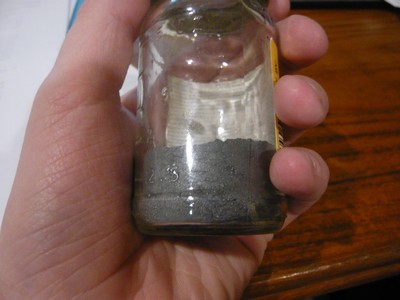
Stuff got a lot darker when in powder form - as a lump it was very bright and shiny, like polished steel. I should have about 120g here.
[Edited on 1-1-2014 by elementcollector1]
Elements Collected:52/87
Latest Acquired: Cl
Next in Line: Nd
|
|
|
| Pages:
1
2
3
4
..
6 |